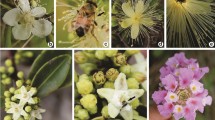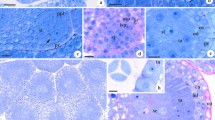Abstract
Aldrovanda vesiculosa (Droseraceae) is a rare aquatic carnivorous plant, distributed in Europe, Asia, Africa, and Australia. Aldrovanda populations can flower prolifically under favourable conditions, but seed set is very limited. We studied the structure of Aldrovanda pollen collected from flowers in different developmental stages (opened and non-opened anthers) from both European and Australian populations to elucidate pollination traits and the basis of poor seed set on the basis of microscopic observation of pollen and anther structure. Microscopic analyses of Aldrovanda pollen showed that this plant has pollen arranged in tetrads like other species in the Droseraceae family. In hydrated pollen, cytoplasmic protrusions originate from pores located along the equatorial wall of monads, and can develop into pollen tubes. Interestingly, pollen development from microspores occurs in open anthers, suggesting a delay of the developmental stages. In addition, pollen development displays altered sperm cell formation and precocious pollen germination. Precocious germination may characterize recalcitrant pollen, which naturally do not undergo dehydration before anthesis and remain partially hydrated, particularly in aquatic and wetland plants. These alterations of male gametophyte development could affect fertilization processes, and be the reason for the low reproductive capability of Aldrovanda observed both in the field and in cultures. Generally, reduced pollen longevity and very quick germination are considered an adaptation to aquatic or wet environments.








Similar content being viewed by others
References
Adamec L (1995) Ecological requirements and the European distribution of the aquatic carnivorous plant Aldrovanda vesiculosa L. Folia Geobot Phytotax 30:53–61
Adamec L (1999) Further notes on flowering and seed set of Aldrovanda vesiculosa. Flytrap News (Sydney) 12(4):9–12
Adamec L (2000) Rootless aquatic plant Aldrovanda vesiculosa: physiological polarity, mineral nutrition, and importance of carnivory. Biol Plant 43:113–119
Adamec L (2018) Biological flora of Central Europe: Aldrovanda vesiculosa L. Perspect Plant Ecol Evol Syst 35:8–21
Adamec L, Tichý M (1997) Flowering of Aldrovanda vesiculosa in outdoor culture in the Czech Republic and isozyme variability of its European populations. Carniv Plant Newsl 26:99–103
Angold RE (1968) The formation of the generative cell in the pollen grain of Endymion non-scriptus (L). J Cell Sci 3:573–578
Atsuzawa K, Kanaizumi D, Ajisaka M, Kamada T, Sakamoto K, Matsushima H, Kaneko K (2020) Fine structure of Aldrovanda vesiculosa L.: the peculiar lifestyle of an aquatic carnivorous plant elucidated by electron microscopy using cryo-techniques. Microscopy (in press):dfaa019. https://doi.org/10.1093/jmicro/dfaa019
Blackmore S, Crane PR (1988) The systematic implications of pollen and spore ontogeny. In: Humphries CJ (ed) Ontogeny and systematics. Columbia University Press, New York, USA, pp 83–115
Brewbaker JL (1967) The distribution and phylogenetic significance of binucleate and trinucleate pollen grains in the angiosperms. Am J Bot 9:1069–1083
Carrizo García C (2002) An approach to the diversity of endothecial thickenings in Solanaceae. Flora 197:214–223
Carrizo García C, Nepi M, Pacini E (2017) It is a matter of timing: asynchrony during pollen development and its consequences on pollen performance in angiosperms—a review. Protoplasma 254:57–73
Cecchetti V, Altamura MM, Falasca G, Costantino P, Cardarelli M (2008) Auxin regulates Arabidopsis anther dehiscence, pollen maturation and filament elongation. Plant Cell 20:1760–1774
Chanda S (1965) The pollen morphology of Droseraceae with special reference to taxonomy. Pollen Spores 7:509–528
Copenhaver GP (2005) A compendium of plant species producing pollen tetrads. J N Carol Acad Sci 121:17–35
Cresti M, Ciampolini F, Pacini E, Sarfatti G, Donini B (1979) Ultrastructural features of Prunus avium L. pollen tube in vivo. Caryologia 32:433–440
Cross A (2012) Aldrovanda. The waterwheel plant. Redfern Natural History Productions, Poole
Cross AT, Skates LM, Adamec L, Hammond CM, Sheridan PM, Dixon KW (2015) Population dynamics of the endangered aquatic carnivorous macrophyte Aldrovanda vesiculosa at a naturalised site in North America. Freshw Biol 60:1772–1783
Cross AT, Adamec L, Turner SR, Dixon KW, Merritt DJ (2016) Seed reproductive biology of the rare aquatic carnivorous plant Aldrovanda vesiculosa (Droseraceae). Bot J Linn Soc 180:515–529
Dawson J, Sozen E, Vizir I, Van Waeyenberge S, Wilson ZA, Mulligan BJ (1999) Characterization and genetic mapping of a mutation (ms35) which prevents anther dehiscence in Arabidopsis thaliana by affecting secondary wall thickening in the endothecium. New Phytol 144:213–222
De Fossard RA (1969) Development and histochemistry of the endothecium in the anthers of in vitro grown Chenopodium rubrum L. Bot Gaz 130:10–22
Elansary HOM, Adamec L, Štorchová H (2010) Uniformity of organellar DNA in Aldrovanda vesiculosa, an endangered aquatic carnivorous species, distributed across four continents. Aquat Bot 92:214–220
Eliseu SA, Dinis AM (2008) Ultrastructure and cytochemistry of Eucalyptus globulus (Myrtaceae) pollen grain. Grana 47:39–51
Erdtman G (1960) The acetolysis method, a revised description. Sven Bot Tidskr 54:561–564
Firon N, Nepi M, Pacini E (2012) Water status and associated processes mark critical stages in pollen development and functioning. Ann Bot 109:1201–1213
Fleischmann A, Cross AT, Gibson R, Gonella PM, Dixon KW (2018) Systematics and evolution of Droseraceae. In: Ellison AM, Adamec L (eds) Carnivorous plants: physiology, ecology, and evolution. Oxford University Press, Oxford, pp 45–57
Franchi GG, Nepi M, Dafni A, Pacini E (2002) Partially hydrated pollen: taxonomic distribution, ecological and evolutionary significance. Plant Syst Evol 234:211–227
Franchi GG, Piotto B, Nepi M, Baskin CC, Baskin JM, Pacini E (2011) Pollen and seed desiccation tolerance in relation to degree of developmental arrest, dispersal, and survival. J Exp Bot 62:5267–5281
Gardner RO (1975) A survey of the distribution of binucleate and trinucleate pollen in the New Zealand flora. New Zealand J Bot 13:361–366
Glöckle B, Urban WJ, Nagahara S, Andersen ED, Higashiyama T, Grini PE, Schnittger A (2018) Pollen differentiation as well as pollen tube guidance and discharge are independent of the presence of gametes. Development 145:e152645
Gómez JF, Talle B, Wilson ZA (2015) Anther and pollen development: a conserved developmental pathway. J Integr Plant Biol 57:876–891
Halbritter H, Hesse M, Weber M (2012) The unique design of pollen tetrads in Dionaea and Drosera. Grana 51:148–157
Herben T, Šerá B, Klimešová J (2014) Clonal growth and sexual reproduction: tradeoffs and environmental constraints. Oikos 124:469–476
Heslop-Harrison J, Heslop-Harrison Y, Cresti M, Tiezzi A, Moscatelli A (1988) Cytoskeletal elements, cell shaping and movement in the angiosperm pollen tube. J Cell Sci 91:49–60
Johnson SA, McCormick S (2001) Pollen germinates precociously in the anthers of raring-to-go, an Arabidopsis gametophytic mutant. Plant Physiol 126:685–695
Kaur S, Nayyar H, Bhanwra RK, Kumar S (2005) Precocious germination of pollen grains in anthers of soybean (Glycine max (L.) Merr.). Soybean Genet Newsl 32:1–10
Kuprianova LA (1973) Pollen morphology within the genus Drosera. Grana 13:103–107
Lora J, Herrero M, Hormaza JI (2009) The coexistence of bicellular and tricellular pollen in Annona cherimola (Annonaceae): implications for pollen evolution. Am J Bot 96:802–808
Lora J, Herrero M, Hormaza JI (2014) Microspore development in Annona (Annonaceae): differences between monad and tetrad pollen. Am J Bot 101:1508–1518
Lord E (1979) The development of cleistogamous and chasmogamous flowers in Lamium amplexicaule (Labiatae); an example of heteroblastic inflorescence development. Bot Gaz 140:39–50
Manning JC (1996) Diversity of endothecial patterns in the angiosperms. In: D’Arcy WG, Keating RC (eds) The anther, form, function and phylogeny. Cambridge University Press, Cambridge, pp 136–158
Marquez J, Seoane-Camba JA, Suarez-Cervera M (1997) The role of the intine and cytoplasm in the activation and germination processes of Poaceae pollen grains. Grana 36:328–342
Nagpal P, Ellis CM, Weber H, Ploense SE, Barkawi LS, Guilfoyle TJ, Hagen G, Alonso JM, Cohen JD, Farmer EE, Ecker JR, Reed JW (2005) Auxin response factors ARF6 and ARF8 promote jasmonic acid production and flower maturation. Development 132:4107–4118
Okada H (2008) Pollination system of Aldrovanda vesiculosa (Droseraceae), a critically endangered aquatic plant in Japan. Makinoa New Ser (Kochi) 7:93–100
Pacini E, Dolferus R (2019) Pollen developmental arrest: maintaining pollen fertility in a world with a changing climate. Front Plant Sci 10:e679
Pacini E, Franchi GG (1982) Germination of pollen inside anthers in some non-cleistogamous species. Caryologia 35:205–215
Pacini E, Hesse M (2005) Pollenkitt – its composition, forms and functions. Flora 200:399–415
Pacini E, Juniper B (1984) The ultrastructure of pollen grain development in Lycopersicum peruvianum. Caryologia 37:21–50
Pacini E, Jacquard C, Clément C (2011) Pollen vacuoles and their significance. Planta 234:217–227
Rodondi G, Beretta M, Andreis C (2004) The genus Drosera L. in northern Italy: pollen morphology as a taxonomic tool. Plant Biosyst 138:157–164
Sahai K, Rawat KK, Gupta D (2016) A note on precocious pollen germination in Woodfordia fruticosa (L.) Kurz. Trop Plant Res 3:606–610
Sahashi N, Ikuse M (1973) Pollen morphology of Aldrovanda vesiculosa. J Jap Bot 48:374–379
Scott RJ, Spielman M, Dickinson HG (2004) Stamen structure and function. Plant Cell 16(Suppl 1):S46–S60
Sirová D, Adamec L, Vrba J (2003) Enzymatic activities in traps of four aquatic species of the carnivorous genus Utricularia. New Phytol 159:669–675
Takahashi H (1988) Ontogenetic development of pollen tetrads of Drosera capensis L. Bot Gaz 149:275–282
Takahashi H, Sohma K (1982) Pollen morphology of the Droseraceae and its related taxa. Sci Rep Res Inst Tohoku Univ (Biol) 38:81–156
Vega-Maray A, Fernández-González D, Valencia-Barrera R, Seoane-Camba J, Suárez-Cervera M (2003) Ultrastructural modifications in the apertural intine of Parietaria judaica L. (Urticaceae) pollen during the early stages of hydration. Grana 42:220–226
Wang Y, Chu YJ, Xue HW (2012) Inositol polyphosphate 5-phosphatase-controlled Ins(1,4,5)P3/Ca2+ is crucial for maintaining pollen dormancy and regulating early germination of pollen. Development 139:2221–2233
Weber HE (1995) Aldrovanda. In: Hegi G (ed) Illustrierte Flora von Mitteleuropa, Band IV, Teil 2A, 3. Auflage. Blackwell Wissenschafts, Berlin, pp 34–37
Whatley JM (1982) Fine structure of the endothecium and developing xylem in Phaseolus vulgaris. New Phytol 91:561–570
Wilson ZA, Song J, Taylor B, Yang C (2011) The final split: the regulation of anther dehiscence. J Exp Bot 62:1633–1649
Xie B, Wang X, Hong Z (2010) Precocious pollen germination in Arabidopsis plants with altered callose deposition during microsporogenesis. Planta 231:809–823
Acknowledgements
Sincere thanks are due to Mr. Curtis Lubbe (Institute of Botany CAS, Třeboň, Czech Rep.) for English correction. Thanks are also due to two anonymous reviewers for correcting the manuscript and valuable comments.
Funding
This research was partly supported by the Czech Long-term research development project No. RVO 67985939 (for LA).
Author information
Authors and Affiliations
Corresponding author
Ethics declarations
Conflict of interest
The authors declare that they have no conflict of interest.
Additional information
Handling Editor: Handling Editor: Peter Nick
Publisher’s note
Springer Nature remains neutral with regard to jurisdictional claims in published maps and institutional affiliations.
Rights and permissions
About this article
Cite this article
Onelli, E., Beretta, M., Moscatelli, A. et al. The aquatic carnivorous plant Aldrovanda vesiculosa (Droseraceae) exhibits altered developmental stages in male gametophyte. Protoplasma 258, 71–85 (2021). https://doi.org/10.1007/s00709-020-01553-6
Received:
Accepted:
Published:
Issue Date:
DOI: https://doi.org/10.1007/s00709-020-01553-6




